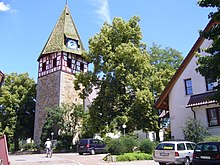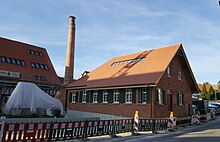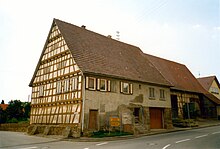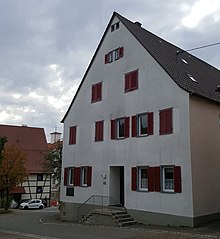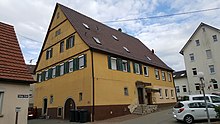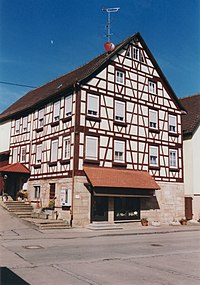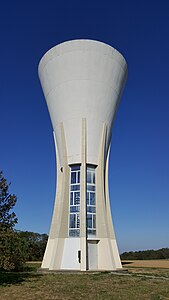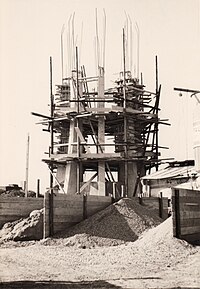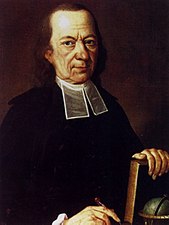Walddorfhäslach
| coat of arms | Germany map | |
|---|---|---|
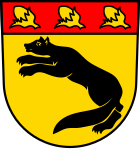
|
Coordinates: 48 ° 35 ' N , 9 ° 11' E |
|
| Basic data | ||
| State : | Baden-Württemberg | |
| Administrative region : | Tübingen | |
| County : | Reutlingen | |
| Height : | 440 m above sea level NHN | |
| Area : | 14.44 km 2 | |
| Residents: | 5227 (December 31, 2018) | |
| Population density : | 362 inhabitants per km 2 | |
| Postal code : | 72141 | |
| Area code : | 07127 | |
| License plate : | RT | |
| Community key : | 08 4 15 087 | |
| LOCODE : | DE DWO | |
| Community structure: | 2 districts | |
| Address of the municipal administration: |
Hauptstrasse 9 72141 Walddorfhäslach |
|
| Website : | ||
| Mayoress : | Silke Höflinger | |
| Location of the community Walddorfhäslach in the district of Reutlingen | ||
Walddorfhäslach is a municipality in Baden-Württemberg , about eleven kilometers north of the district town of Reutlingen . It belongs to the Neckar-Alb region and the European metropolitan region of Stuttgart .
geography
Geographical location
Walddorfhäslach is on the edge of the Schönbuch nature park . The municipal area extends over an altitude of 336 m above sea level. NN in the Schaichtal up to 501 m above sea level. NN on the Walddorfer Platte.
Neighboring communities
The following cities and municipalities border the municipality of Walddorfhäslach, they are named starting clockwise in the north: Aichtal , Schlaitdorf , Altenriet , Neckartenzlingen (all districts of Esslingen ), Pliezhausen ( districts of Reutlingen ), Tübingen , Dettenhausen (all districts of Tübingen ) and Waldenbuch ( districts Boeblingen ).
The largest cities in the area are Stuttgart , Reutlingen and Tübingen .
Community structure
The community consists of the eponymous villages Walddorf and Häslach . Walddorf (about 3100 inhabitants; 1208 hectares) was first mentioned in 1204, Häslach (about 1600 inhabitants; 236 hectares) for the first time in 1310.
The Kächelwang desert lies in the area of the former municipality of Häslach . The place was mentioned around 1120 as Kechelwanck and went off before 1330. In the area of the former community of Walddorf are the abandoned village of Dietenhart, mentioned in 1531 as Diettenhart , and the Geren homestead, which has also been abandoned.
history
overview
The municipality of Walddorfhäslach was created on April 1, 1972 through the merger of the formerly independent municipalities of Walddorf and Häslach, which were then part of the Tübingen district . As part of the district reform, Walddorfhäslach was incorporated into the Reutlingen district in 1973 .
The district Walddorf was the first time on a document from Pope Innocent III. mentioned as Waltdorf . Walddorf probably originated as a settlement in the 7th or 8th century, an indication of this is the ending -dorf in the place name. The discovery of three death trees in 1866 on the west side of the church made this assumption more likely.
The district of Walddorf has been authorized to hold annual markets since the first quarter of the 18th century at the latest and is therefore a market town . With the support of the Tübingen Vogt, a corresponding request was made to the Duke of Württemberg in 1707 . As the central location of the so-called sub-office at that time, it was believed that they had a right to it. Only the responsible city of Tübingen contradicted vehemently. The oldest written evidence that the Trinity Fair was held dates back to 1723. Currently, four general stores are held each year. The markets take place in the main street around the Walddorf town hall.
The name Haselach is dated to 1310. The actual entry certificate was unknown for a long time and one had to refer to the information in the work “The Kingdom of Württemberg. A description by districts, regional offices and municipalities ”, Stuttgart 1904–1907 (Volume II, page 582), the authors of which failed to cite the source. Only shortly before Häslach's 700th anniversary in 2010 was the certificate found in the Reutlingen city archive.
Today it is generally assumed that the place name can be traced back to an earlier job designation, according to which Häslach was the "settlement on a stream on hazel bushes". The composition results from the word parts Häsl for Hasel (hazel bush ) and Ach , an Old High German word for Bach , which also occurs in other city names, such as B. Bacharach , Laufach .
Administrative history
Both communities of origin came from the Count Palatine of Tübingen to the County of Württemberg in the 14th century and are thus typical villages of Altwuerttemberg . At the time of the Duchy, the Kingdom and the Free People's State of Württemberg , the two communities belonged to the Oberamt Tübingen . During the district reform during the Nazi era in Württemberg , the two communities came to the Tübingen district in 1938. In 1945 the villages became part of the French zone of occupation and thus came to the newly founded state of Württemberg-Hohenzollern , which was incorporated into the state of Baden-Württemberg in 1952. Through the district reform in Baden-Württemberg , Walddorfhäslach was assigned to the Reutlingen district in 1973.
religion
Since the Reformation was introduced in Württemberg in 1534, the predominant denomination in both districts has been Protestantism . Walddorfhäslach in the church district of Tübingen has two Protestant churches, including the Walddorf Evangelical Parish Church (Walddorfhäslach) , and one and a half parish offices. Today there is also a Catholic parish hall and a New Apostolic Church.
politics
Municipal council
The community council in Walddorfhäslach has 14 members. The local elections on May 25, 2014 led to the following official final result. The municipal council consists of the elected voluntary councilors and the mayor as chairperson. The mayor is entitled to vote in the municipal council.
| Parties and constituencies |
% 2014 |
Seats 2014 |
% 2009 |
Seats 2009 |
||
| FW | Free electoral association | 45.2 | 6th | 48.4 | 8th | |
| WOMEN | Walddorfhäslach women's list | 20.9 | 3 | 17.3 | 2 | |
| SPD | Social Democratic Party of Germany | 20.3 | 3 | 22.7 | 3 | |
| GREEN | Alliance 90 / The Greens | 13.5 | 2 | 11.6 | 1 | |
| total | 100.0 | 14th | 100.0 | 14th | ||
| voter turnout | 57.8% | 60.1% | ||||
mayor
The mayor is elected for a term of 8 years.
- 1972–1996: Otto Bauer
- 1996-2004: Torsten Pelant
- since 2004: Silke Höflinger
Mayor Silke Höflinger was confirmed in office on April 26, 2020 with 86.6% of the votes. The turnout, despite the election during the COVID-19 pandemic , was 52.2%.
coat of arms
Official blazon: In gold under a red shield head, inside three golden hazelnuts, a slanting black marten. The coat of arms is made up of parts of the earlier municipal coat of arms, the marten comes from the Walddorf coat of arms, the hazelnuts from the Häslacher.
Coats of arms of the former municipalities
 Haslach |
 Forest village |
Partnerships
The partner municipality of Walddorfhäslach is the municipality of Kottmar with the district of Walddorf in Upper Lusatia in Saxony .
Culture and sights
Buildings
To the list of cultural monuments in Walddorfhäslach .
Forest village
Walddorf has some historical buildings, such as the old castle . As part of the 800th anniversary celebration (2004), a historical circular route through Walddorf was laid out, which leads past the historical buildings.
The Protestant parish church in Walddorf is a late Gothic hall church that has been modified several times (built around 1500, the polygonal choir was demolished and the longhouse was extended in a rectangular shape in 1700) with an older tower (12th / 13th century). The half-timbered top of the tower was built around 1500, the eight-sided tent roof is mostly covered with green glazed tiles (18th century). Despite some unfortunate losses in recent years, Walddorfer Hauptstrasse is still predominantly lined with half-timbered buildings from the 18th and 19th centuries. On the barn of the building at Hauptstraße 6, a round arched door with the year 1768 and initials JAB for Johann Jacob Armbruster (1723–1811). The timber-framed building at Hauptstraße 8 owned in the 18th century. the shield economy justice "to the lamb".
The diagonally opposite half- timbered building at Weihergasse 1 was built in 1836 as the home of the mayor Johann Georg Heim (1791–1837), father of Karl von Heim , who later became the mayor of Ulm. From 1838, the Löwen restaurant was located on the upper floor of the building at Hauptstrasse 10 . The commercial building at Hauptstraße 11 goes back to the Denkendorfer Zehntscheune, which was sold to the community in 1850 and passed into private ownership in 1853. After a renovation, this was where Mrs. Maria Nagel's Walddorf post office was located from 1907 - lintel “19. E. Nagel. We. 07 “(Eugen Nagel widow). Kronenwirt Lauxmann had the timber-framed building at Rathausgasse 2 built in 1779. The commercial building at Hauptstrasse 15 was built in 1829 by order of Mayor Johann Georg Nagel (1800–1855). The company GL Nagel housed there was entered in the commercial register of the Kingdom of Württemberg in 1867. Twenty years later (1887) a single-storey shop extension was built on the main street. The mighty, plastered half-timbered building at Hauptstraße 23 , with a very considerable vaulted cellar, has two historically interesting console stones with masks on the stone base, and a four-fold corrugated stone on the northeast corner of the building as well as a timber-frame door and is said to have been built in 1516. The stone carvings are very similar to the so-called Walddorf Castle. In 1565 "Hans Gfrörer, now Michael Wackher" (for this see section Castle) are named as the owner. In the second half of the 17th century. it belonged to the private property of the court master of Einsiedel Castle in Schönbuch. From 1662 at the latest, the "Black Eagle Guest Hostel" was located here and existed until 1800.
The listed Walddorf town hall (Hauptstrasse 9) was built in 1844/45 in place of an older building. The three-storey building consists of a massive base with a classical portal, overlaid half-timbering and a gently sloping gable roof. The roof turret originally contained a fire bell , which was not replaced in 1942 after the forced delivery for armaments purposes.
The archives mention a town hall in Walddorf as early as 1522. It was located in the neighborhood of the Denkendorfer Zehntscheuer and thus presumably at the place of the current building. In 1551 this town hall is described as dilapidated. In 1559 the parish was allowed to acquire and demolish one of two so-called nuns' houses (in fact, these were buildings used by beguines in today's Nonnengasse) with the ducal permission . With the precious building material, a new town hall was built at the traditional location next to the Denkendorfer Zehntscheuer - building material recycling in its purest form. This building then served as the town hall for almost 300 years until it was demolished in May 1844 for the new building.
The main building of the listed, former Gasthof zum Ochsen , in Walddorfer Rathausgasse 6 (dendrochronologically and archivally determined year of construction 1730, extension from 1746, gable from 1882/83), 6a (barn from 1822/23) and 8 (auxiliary building from 1765 - dendro . & archival. - with cellar from 1871), dates back to the first half of the 18th century and is connected to an outbuilding by a covered wooden bridge over Rathausgasse. The bridge once led from the tavern to the dance hall. The local archives already mention Johannes Heim (1666–1723), butcher and "Oxenwürth" in a certificate of division dated December 14, 1715. The Heim family is one of the oldest families still resident in Walddorf today - a Haintz Haim is already mentioned in a stock book for the Schönbuch (“Allt Schonbuch Recht und Gefell”) from 1383.
Since the death of the last ox hostess E. Heim in 2000, the business has been inactive. Due to the neglected building fabric, the final loss of the picturesque ensemble of buildings in the center of Walddorf had to be feared for many years. Now the "ox" and its outbuildings are to be given a future again as part of the renovation of the town center. The renovation in line with listed buildings should be completed by 2020. A historical, wooden tavern sign from the 19th century, with the family coat of arms of the Heim family painted on both sides and a depiction of an ox, has unfortunately been lost.
The listed Walddorf " Dampfmolkerei ", Talbrunnenweg 6, is currently being renovated as part of the town center redevelopment, expected completion: the end of the third quarter of 2019. The single-storey brick building, which originally had a wooden loading ramp with a roof facing Talbrunnenweg, was built in 1893. The client was the “Dairy Cooperative e. G. mu H. ”, to which cattle farmers from Walddorf, Häslach and Gniebel belonged. It was the first milk processing cooperative in the Tübingen district to which the three towns belonged at the time.
In 1896 the cooperative made a profit of 4,059.73 marks from milk and butter sales. In 1910 123,550 liters of milk were processed with a butter yield of 9,952 pounds, the proceeds from butter amounted to 12,969 marks and from buttermilk 410 marks. The cooperative then consisted of 62 members. After electrification in the 1930s, the brick, more than 15 m high chimney had its day. The last milk collection took place on March 31, 1997.
The Talschmiede ( Talbrunnenweg 7) was attached to an existing barn in 1795. The client was the farmer Christoph Luikh (1760–1841). The blacksmith Johannes Dürr had the building converted into a forge in 1913.
The listed, previous notary's office (Brühlstraße 2 in the Walddorf district) was built by the royal Württemberg game master Ernst Friedrich Koch (1750–1824) for himself and his family as a "new forester's house" or "game master". The property remained in the possession of his descendants until 1885, who then sold it to the Walddorf farmer Kaspar Armbruster (1823–1904). Derived from this owner, the building is sometimes still called "Kasperle's house" in local parlance. In 1958, the then still independent community of Walddorf acquired the property from Armbruster's descendants. In 1964 the fire fighting equipment store was set up on the ground floor and the mayor's apartment on the upper floors.
In 1979 the notary's offices were moved from the town hall to the former mayor's apartment. Walddorf had been the notary's office since 1826, the first Walddorf official notary was Christian Friedrich Schnell (born 1797). As part of the notarial reform of the state of Baden-Württemberg, the notarial location Walddorfhäslach was dissolved on January 1, 2018. The community is currently converting the building into a U3 children's home. The "old forester's house" (Brühlstrasse 4) from 1712 was also located in the immediate vicinity, and the owner was the forester Hans Georg Hirsch (1668–1729). Although the building with its peculiar, stepped bay window had been a listed building since 1928, it was demolished in 1955. The half-timbered barn originally belonging to this abandoned building, marked 1789, with a hipped roof and arched basement exit (dated 1766) is listed in the list of immovable architectural and art monuments.
The so-called castle on the corner of Haidlinsgasse and Kappel is a group of buildings from the 16th century. The two-arched courtyard gate bears a Mannerist Renaissance essay. In the apex of the large arch there is a coat of arms with a jug, the initials MW and the year 1607. The stonemason's mark on the courtyard gate is written by Dr. Eduard Paulus 1897 Jerg Mer (c) klin zu, from whom the old town hall from 1608/09 in Wolfschlugen is said to come. On the building to the left of the archway there is a four-fold corrugated stone with a mask, a slightly pointed arched cellar exit and a timber-framed door with a date of 1579, on the Alemannic half-timbered structure the year 1519. The last complete renovation was carried out in the years 1981 to 1983 by the community. The entire property is listed in the register of immovable architectural and art monuments.

Since the Oberamtsbeschreibung Tübingen in 1867, the claim that the Schlosshof building group was the former castle of a local family of Gayern or Geren has persisted. However, recent research by no means confirms these widespread assumptions. The in the family books in the 16th and 17th century. The family members of Geren mentioned above had only modest possessions and mostly practiced the baker's or cooper's trade. Belonging to the lower nobility can practically be ruled out. It can be assumed that they were descendants of the farmers who moved to Walddorf from the farm Gayern / Geren (mentioned in 1383). This farm was in the Dörnach valley - the Geren designation can still be found in the land maps to this day. Furthermore, the archival material does not allow the conclusion that any of the buildings around the castle courtyard were owned by a member of the von Gayern / Geren family.
For the building at Schlosshof 1, the owners had to pay dues to the religious administration in Nürtingen around 1699. This tax obligation, originally for the early mass in Neckartenzlingen, was based on a contract from 1383. In 1540 this recurring interest was paid by "Eberlin Würt zu Waltdorff outside H (a) uss, court raithin and garden by the Felbenbrunnen". In 1587, "Hannß Wackher, called Krautt Hannß, residents and Würth zu Waltdorff" pays interest from this property, and the archives also state that the "Newly built house, Scheur, Hofraytin and garden ... bey dem Felben Bronnen" previously belonged to the “Eberlin Heim dem Würth”. Hannß Wackher († 1603) was with Margareta, b. Heim († 1620) married, probably the daughter of Eberlin Heim. So it is more than conclusive that the builder of the so-called castle was called Hannß Wackher and probably ran a hostel in the building. His son, who was born in 1572 and died in 1635, was called Michael Wackher, whose initials match the initials in the top of the archway built in 1607. In this context, the jug can be interpreted as a symbol for the bar.
On the building to the right of the archway, three arched windows from the end of the 16th century and a timber-framed gable, probably from the beginning of the 17th century.
The listed homestead Kappel 1 with a house from 1794 (visible half-timbered gable on the northeast side) and barn from 1788 had Rösslewirth Johann Georg Heim (1754-1816) built in place of an older building. Already in 1765 a "Schildwuerthschafts Gerechtigkeit" was mentioned for the abandoned building. How long the "Rössle" existed in this building has not yet been conclusively determined.
The former pharmacy (Haidlinsgasse 14) is one of the few remaining buildings from the period before 1900 that was never (partially) used for agricultural purposes. Erected in 1892 by the municipality of Walddorf according to plans by the Tübingen chief architect Wurster, the pharmacy was initially operated as a branch of the Neckartailfinger pharmacy. It was only when the licensed pharmacist Marcus J. Michel took over the pharmacy in 1920 that the Walddorf pharmacy was converted into a full pharmacy. The building has not been used as a pharmacy since 1998.
The Walddorf rectory or rectory certainly dates back to the first half of the 18th century, whereby the stone blocks of the western half of the ground floor are very similar to that of the Walddorf church tower and are therefore likely to be significantly older. There may be a structural connection between the older parts of the rectory and the lower floors of the church tower. A former mansion is suspected in the area of the churchyard . Nobility named after the place first appeared in 1270 with Marquard von Walddorf. After 1408 the family, which had the same coat of arms and partly also the same first names as the lords of Lustnau and Wildenau, seems to have died out. A watercolor from around 1840 shows the unplastered rectory with its pretty ornamental framework. Without the additional structure through the (historically documented) lattice windows, the building looks a bit unbalanced in its current state.
In a description of the parsonage from 1862 (change of pastor Rüdiger - Scholl) it is said that the parsonage is 180 years old, which would mean it was built around 1680. The washing and baking house that still exists was built in 1816 instead of a previous building. The parish barn, built around 1740, was demolished a few years ago. The Romanesque font of the Walddorf church is kept in the walled parsonage. This was removed during the renovation (building officer Heinrich Dolmetsch ) of the church in 1900 and replaced by a new font. See a contract with the ev. Parish according to which the bricklayer Wetzel had to deliver a font made of “beautiful, white, fine-grained, line-free sandstone” at a price of 85 marks by November 28, 1900.
The former farmer forge (Weihergasse 9) was in 1798 the blacksmith Johann Georg Falter (1764-1828) build of an older previous building. Since several farriers found a livelihood in Walddorf in earlier times, name additives were common in everyday language. The Bauerschmiede is named after the Bauer family of blacksmiths who owned the property from 1898.
The listed school building II (Gustav-Werner-Straße 24) has a classicist door panel with the year 1797 and the initials IG and ILGS for Johannes Gaiser and Johann Ludwig Gaiser Schulmeister (1728-1817). The stone ground floor contains parts of an even older building. In the cellar barrel vaults with pointed caps, probably from the 16th century, the door on the cellar neck was built around 1700.
In the former school room on the ground floor three wooden pillars (early 18th century) with simply carved capitals. In 1729 the owner of the building, Johannes Wezel (1663–1729), is referred to as the host of the Reiff. In 1828 the municipality bought the property to use it as a school building. It served this purpose until the new schoolhouse III was built in 1870. The building was then used as a teacher's residence until it was sold into private hands.
The homestead at Kirchgasse 19 was owned by the Gaiser schoolmaster dynasty for three generations from 1694 to 1753. The property came into the possession of the Gaiser family through Barbara, widow of Jakob Stengel, who was married to Hans Gaiser (1606–1694) in 1634. Gaiser was a Walddorf mayor from 1659 to 1661. Local files report that he was badly wounded in the Thirty Years' War when a convoy of 62 tons of powder he was traveling with was blown up, and that he was burned to the bare skin in the hospital for 13 weeks Ulm located. Around 1565 the owner was Hans Felder and around 1610 Hans Schmalacker. The house, a two-storey, clad half-timbered building, dates from the 16th century, the barn is marked 1780. Together with the associated well, the property is listed in the register of immovable architectural and art monuments.
The former Gasthaus zum Lamm (Stuttgarter Straße 2) had the brewer and landlord Johann Jacob Armbruster (1800–1873) built in 1839 instead of a previous building. On November 25, 1839, the building was granted the “Schildwirthschafts Recht”. The large, former hall extension dates from 1931.
On the base of the building in Im Gässle 4, the year 1632 or 1637, the stone block, however, probably in a second use. According to archival evidence, the building was rebuilt in 1713. At that time the owner was (formally) the pastor Johannes Majer (* 1641), who became abbot in Murrhardt on May 12, 1711, but died a short time later, on December 15, 1712. His widow Maria Margaretha apparently returned to Walddorf and died here on August 8, 1719. As early as 1717, however, she had sold the property to the Walddorfer Amtsschultheißen Hans Georg Wezel (1673–1763), whose second wife Anna Maria, nee. Dinner, was related to Maria Margaretha Majer.
No year of construction could be determined for the building Im Gässle 10 so far. However, several clues can be found that suggest a very old age.
The building at Im Gässle 17 was built in 1774 for the linen weaver Jacob Schaal (1734–1803).
The bailiff and clerk Karl Christian Friedrich Ellwert (1785–1824) had the restaurant at the Waldhorn (Stuttgarter Straße 27) built in 1817. His descendants sold the property in 1827 to the baker Carl Heim (1802–1872), who set up the Waldhorn inn there. The hall extension dates from 1911.
Haslach
The townscape of Häslach is shaped by the Protestant church from 1899/1900, architect: Heinrich Dolmetsch, and the distinctive, goblet-shaped water tower from 1967. It has a viewing platform that is not open to the public.
One of the most important historical buildings is that , according to archival sources, the Dorfstrasse 11 building was rebuilt in 1697 for "old" Michael Jehle (n). The commercial building at Dorfstrasse 29 was built in 1848/49 as the home of the farmer Johann Michael Henzler. The bakery (Bauschhausgäßle 2) was built as a private house in 1830, acquired by the Häslach community in 1838 and converted into a community bakery .
|
|
|
|
|
|
|
|
|
|
|
|
Parks
The adjacent Schönbuch Nature Park serves as a local recreation area for the southern Stuttgart region.
In less than an hour you can hike from both districts to the extensive nature reserve Schaichtal , a particularly attractive part of the Schönbuch. Many barbecue areas and several fountains offer the opportunity to rest. Some Häslacher swear by the healing effects of the "Heilbrunnen" water, which is officially not drinking water.
Natural monuments
To the list of natural monuments in Walddorfhäslach Walddorfhäslach has a special natural monument with the several hundred year old Sulzeiche on the edge of Schönbuch near Walddorf.
Economy and Infrastructure
traffic
The community is located on the federal highway 27 ( Blankenburg (Harz) - Lottstetten ). The federal highway 464 connects the community with Böblingen and Sindelfingen .
There is a bus connection to Reutlingen (line 3) within the Naldo (Wabe 220) as well as bus connections to Bernhausen or Degerloch (line 75) and Nürtingen (line 188) within the VVS . Since October 5, 2009, the bus line 300 has been running during rush hour from Walddorf to Dettenhausen, where there is a connection to the Schönbuchbahn to Böblingen.
education
Walddorfhäslach has a primary school , the Römerwegschule Häslach , and a community school , the Gustav-Werner-Schule Walddorf , which runs from the 1st to the 10th grade. In the 2012/13 school year the Gustav-Werner-Schule was one of the starter schools in Baden-Württemberg that became a community school. More than 250 children, young people and adults learn and work together at school. Great emphasis is placed on a pleasant learning environment, polite manners and mutual respect. The Gustav Werner Community School is characterized by a wide range of educational offers that always focus on the individual student. In addition to technical knowledge, the students are also taught social and methodological skills. In addition, extracurricular activities are offered in working groups. For the youngest residents there are two parish and one Protestant kindergarten.
Personalities
sons and daughters of the town
- Stefan Waid , previously often Stephan Waid († 1504), stonemason, foreman (from 1492) at the Esslinger Frauenkirche , 1495 baptismal font in the Michaelskirche (Wangen) , 1501 by the provost in Denkendorf (Württemberg) with the new building of the Peter and Paulskirche Köngen commissioned, 1504 stonemason and foreman at the Konstanzer Münster , married in 1487 to Ursula, the daughter of Hans Böblinger the Elder, also Beblinger. Brother-in-law of the master builder Hans the Younger, Matthäus Böblinger , Marcus, or Marx Böblinger , Lucas, or Lux Böblinger and Dionysius Böblinger the Elder. Waid belonged to the Swabian master builder family Böblinger .
- Karl von Heim (1820–1895), Lord Mayor of Ulm, member of the Reichstag
- Wilhelm Schippert (1907–1980), District Administrator in Backnang
Personalities who work or have worked on site
- Friedrich Christoph Oetinger (1702–1782), well-known Pietist and theologian (most recently prelate von Murrhardt ), was pastor in Walddorf from 1746 to 1752
- Gustav Werner (1809–1887), worked from 1834 to 1840 as vicar in Walddorf.
- Guido Buchwald (* 1961), soccer player and coach, has lived with his family in the Walddorf district for years.
- M. Johann Majer (1641–1712), an important Swabian geodesist and cartographer , was pastor in Walddorf from 1689 to 1711, then prelate in Murrhardt . During his tenure, the Walddorf Church was rebuilt (1699/1700) - the late Gothic polygonal choir was demolished, instead the nave was extended and the rectangular end, and the two late Gothic portals were relocated from the north and south sides to the east and west sides. His map of Württemberg, " Ducatus Würtembergici cum Locis limitaneis nova delineati ", engraved in copper by Johann Baptist Homann in Nuremberg in 1710 , was considered unsurpassed for almost 100 years.
- M. Christian Friedrich Wittich (1757-1818) was a pastor in Walddorf from 1814 until his death in 1818. Even during his time as pastor (1788–1797) of Hundersingen, he wrote pamphlets to improve teaching at the Württemberg rural schools. In 1798 Wittich was named co-editor of the journal “Der Landschullehrer”, which was published by Wohlerschen Buchhandlung in Ulm. From 1786 to 1797 12 years of this “pocket book for German schoolmasters” had already been published, until then Christoph Ferdinand Moser (1759–1800), pastor in Wippingen and Lautern, later in Herbrechtingen , was solely responsible for these works. For the 1798 edition he secured the collaboration of Pastor Wittich.
Individual evidence
- ↑ State Statistical Office Baden-Württemberg - Population by nationality and gender on December 31, 2018 (CSV file) ( help on this ).
- ^ The state of Baden-Württemberg. Official description by district and municipality. Volume VII: Tübingen administrative region. Kohlhammer, Stuttgart 1978, ISBN 3-17-004807-4 . Pp. 59-30
- ^ Federal Statistical Office (ed.): Historical municipality directory for the Federal Republic of Germany. Name, border and key number changes in municipalities, counties and administrative districts from May 27, 1970 to December 31, 1982 . W. Kohlhammer, Stuttgart / Mainz 1983, ISBN 3-17-003263-1 , p. 535 .
- ↑ "Gugelhöpf" for the "Mädla" . In: Reutlingen General-Anzeiger . Reutlingen March 5, 2003, p. 10 .
- ^ From the Walddorfer Märkt or how Walddorf became a market town . In: Community Walddorfhäslach (ed.): 800 years Walddorf 1204 - 2004 . Walddorfhäslach 2004, p. 42-45 .
- ↑ Häslach 700 years . Walddorfhäslach community, Walddorfhäslach 2010
- ↑ Across steep Stäffele - old Walddorf houses: the "Löwen" inn . In: Reutlingen General-Anzeiger . Reutlingen August 25, 2001, p. 15 .
- ↑ Set the clock after the post office - Old Walddorf houses: Zehntscheuer became a post office . In: Reutlinger General-Anzeiger . Reutlingen July 31, 1999, p. 20 .
- ↑ A master baker as a “chauffeur” - Alte Walddorf houses: At the “Pfarrbeck” today there are stamps instead of bread rolls . In: Reutlinger General-Anzeiger . Reutlingen July 3, 1999, p. 19 .
- ↑ French biscuits and Turkish currants - Old Walddorfhäslacher houses: the "department store" in the main street - And who was "L. Nail"? In: Reutlinger General-Anzeiger . Reutlingen June 30, 2001, p. 19 .
- ↑ The parent company of the Wezels and Wetzels - old Walddorfer houses: The "Black Eagle" was the first restaurant in town - a listed building is being renovated . In: Reutlinger General-Anzeiger . Reutlingen May 8, 1999, p. 18 .
- ↑ Wolfgang Bauer: Shortly before decay: One of the oldest half-timbered houses in Walddorf is being restored . In: Schwäbisches Tagblatt . June 12, 1998, p. 40 .
- ^ Renewal of the parish and early mass at Waltdorff . In: Landesarchiv Baden-Württemberg, Main State Archives Stuttgart (Ed.): H 102/75 . tape 10 , 1565.
- ^ Fromm-Kaupp MA: Directory of immovable architectural and art monuments and the objects to be examined in the Tübingen administrative district, Reutlingen district, Walddorfhäslach community . Ed .: State Monument Authority Baden-Württemberg. 1999.
- ↑ Extremely well and beautifully done . In: Community Walddorfhäslach (ed.): 800 years Walddorf 1204–2004 . Walddorfhäslach 2004, p. 28-30 .
- ↑ Most of them only drink cider - Alte Walddorf houses: For more than 280 years, the ox farmers were called Heim . In: Reutlingen General-Anzeiger . Reutlingen March 9, 2002, p. 12 .
- ↑ Nobody had to die of thirst or Walddorf inns in the old days . In: Community of Walddorfhäslach (ed.): 800 years of Walddorf 1204-2004 . Walddorfhäslach 2004, p. 115 .
- ↑ The steam dairy on the “Milky Way” . In: Reutlingen General-Anzeiger . Reutlingen April 13, 2002, p. 18 .
- ^ State archive administration Baden-Württemberg (ed.): The district of Tübingen . tape 2 . Stuttgart 1972, ISBN 3-17-258321-X , p. 742 (1967-1974).
- ^ Dairy Cooperative Walddorf e. G. mu H. - Balance as of January 1, 1897 . In: Tübinger Chronik .
- ↑ The Walddorf dairy cooperative had brisk sales in the 1910 financial year . In: Reutlingen General-Anzeiger . Reutlingen April 20, 1911.
- ↑ Mirjam Sperlich: No more fresh milk - after 103 years, the Walddorf whey has closed . In: Reutlinger General-Anzeiger . Reutlingen April 4, 1997, p. 15 .
- ^ A royal official notary for Walddorf or the history of the notary's office . In: Community of Walddorfhäslach (ed.): 800 years of Walddorf 1204-2004 . Walddorfhäslach 2004, p. 38-41 .
- ↑ Rich builder - old Walddorf houses: the notary's office at Brühlstrasse 2 . In: Reutlinger General-Anzeiger . Reutlingen June 29, 2002, p. 20 .
- ^ Wilhelm Böhringer: From former Walddorf forest houses . In: Local history sheets for the Tübingen district . No. 20 . Tübingen October 1966.
- ↑ Dr. Eduard Paulus: Due art and antiquity monuments in the Kingdom of Württemberg . Paul Neff, Stuttgart 1897, p. 430 .
- ^ Clerical administration Nürtingen . In: Baden-Württemberg State Archives, Stuttgart Main State Archives . tape 24 , H 102/59, 1699, pp. 935 .
- ↑ Certificates & contracts . In: Landesarchiv Baden-Württemberg - Main State Archive Stuttgart (Ed.): A 602 . No. 12475 , 1369.
- ↑ The Friamess Tintzlingen annual income . In: Baden-Württemberg State Archives, Stuttgart Main State Archives . tape 5 , H 102/59, 1540, p. 136 .
- ↑ Renewal of the ecclesiastical administration to Nürtingen - formerly Waltdorff Tüwinger Ampts . In: Baden-Württemberg State Archives, Stuttgart Main State Archives . tape 9 , H 102/59, 1587, p. 403 .
- ↑ Hot must instead of medicine? - Old Walddorf houses: The first local pharmacy opened in 1892 at Haidlinsgasse 14 . In: Reutlinger General-Anzeiger . Reutlingen April 10, 1999, p. 15 .
- ↑ Theodor Schön: The Lords of Walddorf . In: Reutlinger Geschichtsblätter . No. 6 , 1895.
- ↑ Dr. Max Flad: Happy time in Biberach - memories of Marie Becker geb. Müller of her childhood in Biberach . In: Society for Home Care (Art and Antiquity Association) Biberach e. V. (Ed.): Local history sheets for the district of Biberach . 1992, p. 22 .
- ↑ Dr. Eduard Paulus: The art and antiquity monuments in the Kingdom of Württemberg . Paul Neff, Stuttgart 1897, p. 429 .
- ↑ Your fingers burned on the horseshoe - Old Walddorf houses: The “farmer's forge” in Weihergasse . In: Reutlinger General-Anzeiger . Reutlingen July 28, 2001, p. 18 .
- ^ Günther Schweizer: Seven generations of schoolmasters - The Gaiser family from Walddorf near Tübingen . In: Association for Family and Heraldry in Württemberg and Baden e. V. (Ed.): Southwest German sheets for family history and heraldry . tape 26 , 2008, p. 131 ff .
- ^ State archive administration Baden-Württemberg (ed.): The district of Tübingen . tape 2 . Stuttgart, S. 739 (1967-1974).
- ↑ The Evang. Elementary schools in Württemberg . Friedrich Bühler'sche Buchdruckerei, Urach 1897, p. 418 .
- ^ Günther Schweizer: Seven generations of schoolmasters - The Gaiser family from Walddorf near Tübingen . In: Association for Family and Heraldry in Württemberg and Baden e. V. (Ed.): Southwest German sheets for family history and heraldry . tape 26 , 2008, p. 131 ff .
- ↑ Two vaulted cellars, built on rocks - Old Walddorf houses: The “Gasthaus zum Lamm” in Stuttgarter Straße - “Wochenschau” once a week . In: Reutlinger General-Anzeiger . Reutlingen July 14, 2001, p. 17 .
- ↑ The horses were also taken care of - old Walddorfer houses: Many timber farmers from the Fildern once frequented the “Waldhorn” . In: Reutlingen General-Anzeiger . Reutlingen April 24, 1999, p. 20 .
- ^ State archive administration Baden-Württemberg (ed.): The district of Tübingen . tape 2 . Stuttgart 1972, ISBN 3-17-258321-X , p. 737 (1967-1974).
- ↑ Erhardt Schmidt: Findings in the Protestant church in Walddorf, community Walddorfhäslach, district Reutlingen . In: Archaeological excavations in Baden-Württemberg 1986 . Konrad Theiss Verlag, Stuttgart 1987, ISBN 3-8062-0500-0 , p. 228-231 .
- ^ Landesvermessungsamt Baden-Württemberg (Ed.): 150 Years of Württemberg State Surveying 1818-1968 . Stuttgart 1968.
- ^ Robert Uhland: Johann Majer - a Württemberg cartographer - the creation of the first modern map of Württemberg . In: Journal for Württemberg State History . 1954, p. 220-248 .
- ^ Educational pamphlets . In: Carl Ernst Bohn (ed.): New general German library . tape 40 . Kiel 1798, p. 58 .
Web links
- Official website of the municipality
- Heimat Walddorfhäslach (information is freely accessible)
- Private website for the OT Walddorf with lots of information






